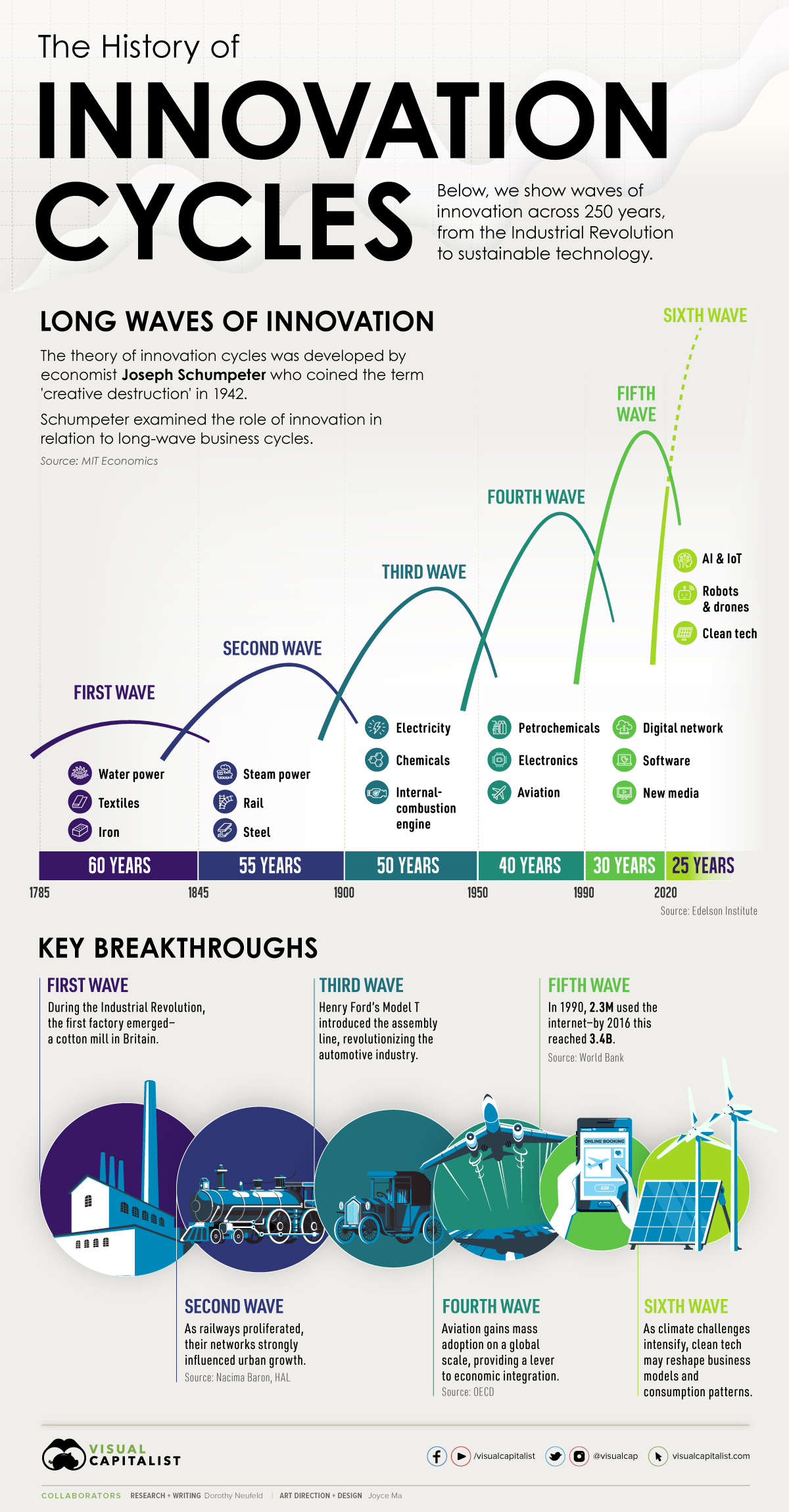Key Takeaway
Innovation cycles, as described by the theory of “creative destruction” coined by economist Joseph Schumpeter, have historically played a crucial role in shaping economies. The article explores the impact of six waves of innovation, from the Industrial Revolution to the current era marked by digitization and artificial intelligence. These cycles bring about significant changes, driving economic growth, but can also lead to monopolies and market power concentration.
Here is the article using the provided table:
Major Innovation Waves Through History
Throughout history, human civilization has experienced waves of technological innovation and progress. These waves, driven by key technological advancements, have transformed economies and societies.
The First Wave: Water Power, Textiles, and Iron
The First Wave of innovation lasted around 60 years, beginning in 1785. It was driven by advances in water power, textile manufacturing, and iron production. The water wheel and steam engine drove mechanization in textile mills, enabling mass production of textiles. Innovations in iron and steel manufacturing also emerged during this period.
The Second Wave: Steam, Rail, and Steel
Beginning around 1845, the Second Wave spanned 55 years. It was characterized by railroads, steamships, the telegraph, and mass production enabled by steam power, railroads, and steel. The steam engine allowed more efficient movement of goods and people. Railroad networks expanded rapidly, connecting communities. Steel production scaled up.
The Third Wave: Electricity, Chemicals, and Internal Combustion
The Third Wave emerged around 1900, lasting 50 years. Major drivers were electricity, chemicals, and the internal combustion engine. Electrification changed manufacturing. Chemicals like explosives and fertilizers led to new products. Gas-powered automobiles and airplanes transformed transportation.
The Fourth Wave: Petrochemicals, Electronics, and Aviation
Beginning in 1950, the 40-year Fourth Wave saw innovations in petrochemicals, electronics, and aviation. Oil and gas were harnessed to develop plastics and other petrochemical-derived materials. Rapid advances emerged in electronics and aviation, exemplified by television and jet aircraft.
The Fifth Wave: Digital, Networks, Software, and Media
The Fifth Wave, beginning around 1990 and lasting 30 years, was driven by the rise of digital technology, networks, software, and new media. The computer and internet connected the world like never before. Software improved enterprise and efficiency. New digital media like the web transformed communications and media.
The Sixth Wave: Digitization, Clean Tech, and Automation
Emerging around 2020 and expected to last 25 years, the Sixth Wave is characterized by digitization through AI, IoT, autonomous vehicles, robotics, drones, and clean technologies. Sensors and AI are enhancing digitization across industries. Clean energy solutions are expanding. Automation through robots, drones, and autonomous vehicles could disrupt transportation, manufacturing, and many sectors.
| Wave | Key Drivers | Duration | Estimated Start Date |
|---|---|---|---|
| First Wave | Water Power, Textiles, Iron | 60 years | 1785 |
| Second Wave | Steam, Rail, Steel | 55 years | 1845 |
| Third Wave | Electricity, Chemicals, Internal-Combustion Engine | 50 years | 1900 |
| Fourth Wave | Petrochemicals, Electronics, Aviation | 40 years | 1950 |
| Fifth Wave | Digital, Network, Software, New Media | 30 years | 1990 |
| Sixth Wave | Digitization (AI, IoT, AV, Robots & Drones), Clean Tech | 25 years | 2020 |

Summary
- Creative Destruction Theory:
- Coined by Joseph Schumpeter, it suggests that long waves of innovation, leading to creative destruction, are integral to business cycles.
- Historical Impact of Innovation Cycles:
- The article provides examples of how past innovations, such as railways and the internet, have reshaped industries and urban landscapes.
- Six Waves of Innovation:
- First Wave: Industrial Revolution with water power, textiles, and iron.
- Second Wave: Rail, steam, and steel advancements.
- Third Wave: Electricity, Model T, and assembly line.
- Fourth Wave: Aviation revolution.
- Fifth Wave: Internet, new media, and globalization.
- Sixth Wave: Current era marked by digitization, AI, IoT, robotics, and drones.
- Market Power and Monopolies:
- Innovations drive economic growth but can lead to monopolies during upswings in the innovation cycle.
- Current parallels with Big Tech dominating global markets and information.
- Future Trends:
- The article predicts the sixth wave, focusing on AI, digitization, and clean tech.
- Anticipates automation, predictive analytics, and data processing impacting goods and services.
- Climate Concerns and Clean Tech:
- Highlights the growing importance of addressing climate concerns within technological innovations.
- Lower costs in solar PV and wind contributing to efficiency advantages.
- Shortening Cycle Longevity:
- Observes a trend of decreasing cycle longevity, with the fifth wave potentially having a few years left.
- Global Connectivity:
- Acknowledges the unprecedented global connectivity, drawing parallels with the 19th-century rail industry’s influence on prices and competition.
- Waves of Change:
- Emphasizes the dynamic nature of innovation cycles, continually shaping the economic landscape.
- Conclusion:
- The article encourages readers to contemplate the historical and future implications of innovation cycles, recognizing their transformative impact on societies and economies.

